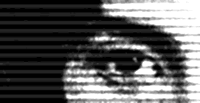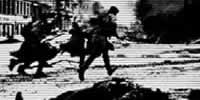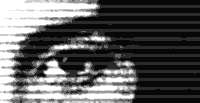|
|
¬ a n d a l u s i a n m e m o r i e s
...cont
in how far is memory a definition of oneself, & in
this respect, is it created anew or rather fixed in the unconscious? memory
triggered or held by an artefact, foto or smell is a memory that is safely
framed in the past.
memory is unreliable, we can never tell in how far it is invented. it
also is not experienced in a linear way, rather like images in a random
sequence, closer to what we call a dream. the exclamation of death is
what I would call a second grade memory: the factual contents were being
told to me by my grandmother. these memories are not fixed, though, as
I could refer back to them, when I read my grandfather’s letters
from the eastern front last summer. “what was it like during the
war?” was my inevitable question when I was a young boy, my grandmother
sitting in front of her beloved tv. I remember her reluctance, & she
always told the same story. yet I was patient, & every now & then
a new aspect came to light. the older I became, the more information I
was given. I must say though, that even when I was really young I had
a notion of relativity in my thoughts: I knew, it was HER memory, HER
history & not anyone else’s. & it was only what she kept
in her mind, what she consciously selected or not, that what she was telling
me was merely an excerpt of the whole picture. she never talked of my
grandfather a lot, because these memories were either a private matter
or were being excluded from her life in order to make the loss more bearable.
truth, illusion, selection.
distance, individual experience, history.
results: fragmented, blurred, convenient.
these are the notions which are re/presented in andalusian memories.
framed deterioration
historic photography and films show selected frames &
images in order to document what happened in a certain location at a certain
time. the boundary towards fiction is blurred, as documentaries are used
for propaganda or showing specific circumstances from a distinct angle.
in this respect they share notions of memory as described above, in recontextualizing
aspects of “reality”. displayed images are always selected,
they can never stand alone for what they are.
I filmed found footage from a monitor, selecting only a part of the original
image. the images were distributed over two thirty minute s-vhs tapes
which share an ongoing theme: the opening scene of the andalusian dog
by salvatore dali in which an eye of a rather pretty woman is sliced with
the blade of a scalpell. this scene frames the other scenes in between,
which mostly deal with destruction (the burning hindenburg zeppelin, war
scenes, conflict & entropy). these scenes were chosen in order to
reflect the sickness of the times my memories are referring back to. unlike
war documentaries, which pretend to capture the whole scene, here, only
parts of the original frames were filmed degraded & blurred in close
up shots, fast forwards & zoom outs. the images themselves become
destructed; in this way the form reflects their content, although not
explicitely visible at all times. as a rule i did not allow myself to
reedit captured footage, because what is done is done, just like in real
life. memory has to deal with the consequences, if one likes them or not.
film & memory share a constructed notion of the “real”,
i.e. a frame locates the moment.
the presentation itself was to show three frames of projected
material: here it is important to point out the importance of layering
& superimposing the images, so that the existent patterns can interfere
with each other & subsequently link up chunks of information. the
third frame was planned to be supplied by a life-camera which captures
parts of the pre-videoed ones.
a film or video shows animated images in a linear way,
but, as we have seen, this is not the way memory works. hence the films
were stopped at crucial moments which shows an inherent aesthetic of film:
the freeze-frame or still. i find it amazing how a film frame gains momentum
by being stopped. also, in terms of narration, a focussing takes place,
the freeze-frame becomes a kind of land-mark, an image, that can be remembered.
mediation
most importantly the footage used in andalusian memories
is processed: video as a medium degrades the quality of the frames, enhances
colours or adds them to blach & white frames, although this is not
meant to be this way. this feature is beyond the control of the film-maker
or artist & can be exploited as the message of the form, the materiality,
the mediation process.
it was an important thing to film directly off a television screen, the
conventional way to display video. the screen adds lines to the image,
this in itself shows mediation & makes us aware of the unreliable
“truth” of the images shown. they are literally lifted off their
original context.
additionally the final frames show only a part of the original in order
to enhance a notion of closure which is what we do not see, but assume
there is. blurred & censored vision has to be corrected by applying
fantasy, rewriting the film as it is shown with the result that (presumably)
no viewer sees exactly the same version, especially as the eye flicks
from one chosen frame to the other, the flow of images being interrupted
by stills & fast forwards. this is a selective activity which was
also exercised by me in deciding where to stop the films; also the sped
up scenes quite nicely represents how we skip or speed up scenes in our
memories because they are unpleasant or intolerable..
~~three frames out of sync always held absent from the
extreme precision of abrupt ruptures. sound restores the meaning, intimate
as on a freeze. secret friction between the most tenuous events, action
beyond the frame, transit, traversed as in a poem, heading through the
threat struck with the spatial aesthetics of memory, becoming unreliable
remains turned inside out.
the hidden origin and end: long ago or still to come, old images that
are broken, people in slow motion marching in an unknown place, of faces
and bodies placed in history between a strong life and a slow death that
would come without their remembering anything.
it was perhaps inevitable, others seem to indicate but not define us as
more or less appropriate pawns in a game of chess.~~
(original text in italics by C.Akerman:Bordering of Fiction Walker Art
Centre 95, cut up, scanned & edited).
|



|
![]() index | top
index | top